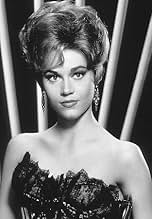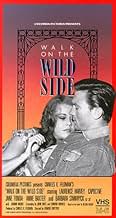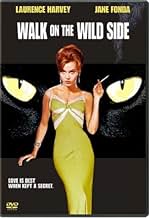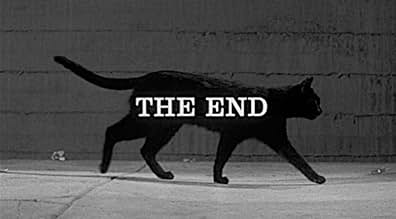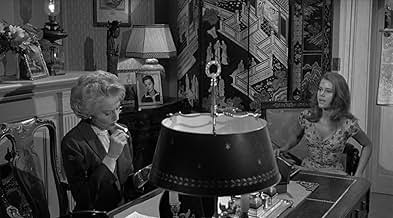Un hombre llega a Nueva Orleans buscando a su antigua novia, una artista que ahora trabaja en un burdel.Un hombre llega a Nueva Orleans buscando a su antigua novia, una artista que ahora trabaja en un burdel.Un hombre llega a Nueva Orleans buscando a su antigua novia, una artista que ahora trabaja en un burdel.
- Dirección
- Guionistas
- Elenco
- Nominado a 1 premio Óscar
- 1 nominación en total
- Dockery
- (as Donald Barry)
- Lt. Omar Stroud
- (as Todd Anderson)
- Diner in Teresina's Cafe
- (sin créditos)
- 2nd Van Driver
- (sin créditos)
Opiniones destacadas
All this sounds quite simple, but its treatment and style is such that you feel its down-in-the-dirt quality and you get the feeling it's a guilty pleasure in watching it. It also features Juanita Moore, from "Imitation of Life" with Lana Turner, and Joanna Moore (who was the mother of Tatum O'Neal) has a very memorable if somewhat brief role.
For all the great stars and talent in the making of this movie, the one person you really empathize the most for is Anne Baxter, who comes to feel something for Laurence Harvey. Everyone else, including Laurence and Jane, are portrayed as somewhat selfish and hard in their own way; in other words, these are not very likable people. Even Capucine, who the viewer is supposed to feel sorry for in her predicament, doesn't really emote enough feelings for the viewer to really care about her.
I know I seem to be giving it a hard time, but I give it an '8' for its entertainment value and presentation with some of the best actors of the time. Like always, Stanwyck is great, and Anne Baxter's accent is so natural, you see the character and not Anne, which is a testimony to her acting chops. So, walk on the wild side with Stanwyck & company.
Laurence Harvey has the Southern accent down. And, as for Jane Fonda, this was the one break in her endless string of coy sex kitten roles from the sixties where she proves she can act. Some say she overdoes it, but I think she provides the real spice in this film.
In the midst of this batch of newcomers hobbled together from around the world (although they're all playing indigenous Southerners) are two pros trained in the old Hollywood studios. This is hardly a high point for Barbara Stanwyck. But, she proves that you can put her down anywhere - in a screwball comedy, a tearjerker, a hard-boiled film noir, or a TV western - and she can hold her own.
Anne Baxter acquits herself well in the thankless task of playing a humble Mexican. Probably less well known for her accomplishments than Stanwyck, she won an Oscar for playing one of the greatest dramatic arcs given to an actress in the forties in "The Razor's Edge." These two pros give some dignity to a film that easily could have degenerated in to laughable kitsch.
This film is notorious for its overt portrayal of a lesbian character. But, it actually has a more interesting gay connection. Fonda, against the prohibition of director Edward Dymyrik, was secretly being coached in her dressing room by her 'secretary' and live-in boyfriend Andreas Voutsinas. Six years later, he would set a new benchmark for outrageous mincing queens as Carmen Ghia in Mel Brooks' "The Producers."
Throughout, both the music and the B&W cinematography evoke a noirish, downbeat mood totally in sync with the film's theme of embittered sleaze. Although set in the 1930's, the film looks and sounds more like something from the hip, "beat" generation of the 1950's. And I'm comfortable with that.
What I'm not comfortable with is the casting and the screenplay. Lithuanian born Laurence Harvey is totally not convincing as a Texas tramp. French born Capucine, looking like she just walked in from the set of "La Dolce Vita", seems lost in the role of a Southern belle. A somewhat inexperienced Jane Fonda overacts the role of Kitty Twist. And American Anne Baxter, looking more like Suzanne Pleshette than Anne Baxter, plays a Mexican senorita, with the help of a big wig. Among the major roles, the only credible cast member is Barbara Stanwyck, as the bossy owner of the Doll House, your typical red light house of prostitution.
The film's red light title is a big tease. It advertises brothel life, but the screenplay delivers only boredom and preachy morality. But in 1962 the moralistic Hays Code still exerted influence on what Hollywood could say and show. The result here is a yellow light plot that merely hints at sleaze.
Forty years after its release, "Walk On The Wild Side" does have entertainment value, both as a curious period piece, and as a sudsy soap opera with some campy dialogue, helped along by the always engaging Barbara Stanwyck.
¿Sabías que…?
- TriviaSeveral contemporary reviewers mentioned that, although the film was set in the 1930s, Capucine seemed to be wearing contemporary (1962) fashions. Director Edward Dmytryk stated that it was because she was the "protégé" (i.e., live-in girlfriend) of producer Charles K. Feldman, who decreed that, despite the film's 1930s setting, she would be dressed in the latest Pierre Cardin designs.
- ErroresThe jukebox in Teresina's diner is a Wurlitzer model 1015. The 1015 was a post-war model produced from 1946 through 1947 and would not have been seen in the Depression.
- Citas
Preacher: Jezebel! That's right, I mean you! Now both of you sinners are hurrying past.
Dove Linkhorn: You got no business with us mister.
Preacher: Oh, sinners is my business. You and that hip-slinging daughter of Satan. You know there's the smell of sulfur and brimstone about you. The smell of hellfire.
Dove Linkhorn: Who ordained preacher?
Preacher: I am self-ordained son; I had the call.
Dove Linkhorn: You were called by the wrong voice mister.
Preacher: Lord strike this sinner down. Send a bolt down to smite and consume the blasphemer now!
Dove Linkhorn: He won't hear you. Cause you no friend of God or man - standing there hollering hate to the world. God is love. God is mercy and forgiveness. Try preaching that sometime Mr. Preacher. Teach people to forgive, not to crawl in fear. Teach people to love, not hate. preach the good book - preach the truth.
- Créditos curiososThe opening and closing credits are shown tracking a black cat as it prowls an urban landscape. The closing credits feature a newspaper reporting the Doll House residents' arrest and conviction.
- ConexionesEdited into Bass on Titles (1982)
- Bandas sonorasWalk on the Wild Side
(uncredited)
Music by Elmer Bernstein
Lyrics by Mack David
Sung by Brook Benton
[Played as Hallie walks down to the first party shown at the Doll House]
Selecciones populares
Detalles
- Fecha de lanzamiento
- País de origen
- Idiomas
- También se conoce como
- Walk on the Wild Side
- Locaciones de filmación
- French Quarter, Nueva Orleans, Luisiana, Estados Unidos(Several street shots.)
- Productora
- Ver más créditos de la compañía en IMDbPro
- Tiempo de ejecución1 hora 54 minutos
- Color
- Relación de aspecto
- 1.85 : 1
Contribuir a esta página


